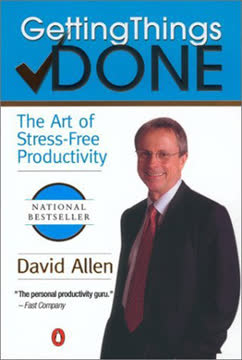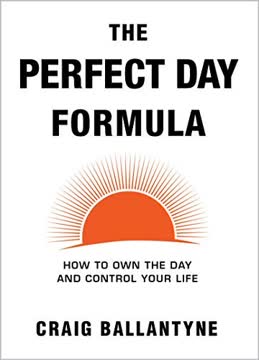Key Takeaways
1. Master Your Inbox, Master Your Day
Instead of starting the day off proactively, you’ve now flipped the switch to a reactive mode.
Email first thing is a trap. Diving into your inbox first thing in the morning sets a reactive tone for the entire day. Instead of focusing on your priorities, you're immediately responding to other people's needs and demands. This can lead to feeling overwhelmed and losing control of your schedule.
Strategies for inbox mastery:
- Schedule specific times for checking email, rather than constantly monitoring it.
- Turn off push notifications to minimize distractions.
- Use filters and folders to organize your inbox and prioritize messages.
- Craft email templates for frequently asked questions to save time.
Zero inbox is the goal. Aim to keep your inbox at zero by processing each email immediately: respond, file, delete, or snooze for later action. This prevents your inbox from becoming a source of stress and allows you to focus on more important tasks.
2. Time Blocking: Your Blueprint for a Productive Day
With time blocking, you know exactly how much time you have each day for each task on your to-do list.
Allocate time for everything. Time blocking involves scheduling specific blocks of time for each task on your to-do list, including everyday activities like meals and chores. This provides a clear visual representation of your day and helps you stay on track.
How to implement time blocking:
- Create a prioritized to-do list.
- Estimate the time required for each task.
- Allocate specific time blocks in your calendar for each task.
- Plan your schedule at least one day in advance.
Flexibility is key. While time blocking provides structure, it's important to remain flexible and adjust your schedule as needed. Unexpected events will inevitably arise, so be prepared to reprioritize and reschedule tasks.
3. Prioritize Ruthlessly: Focus on What Truly Matters
Knowing how to prioritize your tasks will make it easier for you to be more productive and get more done.
Urgent vs. Important. Not all tasks are created equal. Learn to distinguish between urgent tasks (those that require immediate attention) and important tasks (those that contribute to your long-term goals). Prioritize important tasks, even if they don't feel urgent.
Strategies for prioritization:
- Write down all your tasks, appointments, and obligations.
- Determine what is urgent and what can wait.
- Add tasks related to your short-term and long-term goals.
- Assign deadlines to each task.
- Create a time-blocked schedule based on your priorities.
Simplify, automate, batch, delegate. To free up time for your priorities, simplify unnecessary tasks, automate repetitive tasks, batch similar tasks together, and delegate tasks to others when possible.
4. Declutter Your Life, Declutter Your Mind
Neatness—at home and at work—not only brings ease into your life, but it also allows you more time to focus on your family and friends.
Physical clutter, mental clutter. A cluttered environment can lead to a cluttered mind, making it difficult to focus and be productive. Decluttering your home, office, and car can have a significant impact on your mental clarity and well-being.
Decluttering techniques:
- Use the reverse-hanger trick to identify clothes you don't wear.
- Employ the four-box method (donate, relocate, sell, trash) to declutter your home.
- Remove expired products from your bathroom and kitchen.
- Organize your workspace by consolidating items and moving to a virtual filing system.
Nightly routine for success. Establish a nightly routine that includes planning, prepping, and returning items to their proper places. This sets you up for a smoother and more productive morning.
5. Meetings That Matter: Efficiency is Key
A meeting is only as good as its agenda.
Purposeful meetings are productive meetings. Meetings should have a clear purpose, a well-structured agenda, and a designated time limit. This ensures that meetings are focused, efficient, and productive.
Meeting best practices:
- Develop an agenda early and distribute it to attendees in advance.
- Include only necessary personnel.
- Designate a starting and stopping point.
- Stay on topic and avoid tangents.
- Conclude the meeting with a summary of action items.
Virtual meetings require extra prep. For virtual meetings, ensure that all participants are familiar with the platform being used and have tested their equipment in advance. Establish meeting rules to minimize distractions and encourage engagement.
6. Sharpen Your Focus: Eliminate Distractions
With a constant stream of stimuli vying for our attention, it’s harder than ever to focus on what’s really important in life.
Digital distractions are everywhere. Smartphones, social media, and the internet offer endless distractions that can derail your focus and productivity. It's crucial to establish boundaries and eliminate these distractions.
Strategies for sharpening focus:
- Practice being bored to resist the urge to seek novel stimuli.
- Plan your goals in reverse to create a clear action plan.
- Focus on completing one task at a time, rather than multitasking.
- Communicate your needs clearly and proactively to avoid delays.
- Learn to listen actively to prevent misunderstandings.
Go old school to avoid digital distractions. Swap out digital apps for physical products like notebooks, calendars, and cameras to limit your device usage.
7. Self-Care Isn't Selfish: Recharge to Thrive
Self-care is not self-indulgent; it is a necessary component to maintaining your well-being and staying on track.
Prioritize your well-being. Self-care is essential for maintaining your mental, physical, and emotional well-being. It's not a luxury, but a necessity for staying on track and achieving your goals.
Self-care activities:
- Exercise regularly.
- Eat healthy foods.
- Get enough sleep.
- Practice yoga, meditation, or relaxation techniques.
- Pursue creative outlets.
- Engage in psychotherapy.
Take breaks to refuel. When you're feeling overwhelmed, take short breaks to recharge your batteries. Even a 15-minute break can make a significant difference in your focus and productivity.
8. Customize Your Approach: Find What Works for You
There is no “one size fits all” in time management, only suggestions and tips for strategies that have worked well for others and that may work for you.
Experiment and adapt. Time management is a personal journey. Experiment with different techniques and strategies to find what works best for your personality, situation, and goals.
Night owl or early bird? If you're a night owl, tackle your most important tasks later in the day when you're more alert. If you're an early bird, focus on your most critical work first thing in the morning.
Create your own systems. As you become more efficient, you may develop your own unique systems and methods. Be open to innovation and adapt your approach as needed.
9. Commit to the Process: Consistency is King
Sticking to good habits can be hard work, and mistakes are part of the process.
Time management is a journey, not a destination. There will be times when you fall out of your newly formed habits. When this happens, don't give up. Pick back up where you left off and start again.
Reinforce good habits. Find an accountability partner to help you stay on track. Create a reward system to motivate yourself to achieve your goals.
Be intentional with your actions. Make conscious decisions to be intentional with your actions. Choose activities that align with your goals and values.
Last updated:
Review Summary
Time Management in 20 Minutes a Day receives generally positive reviews, with readers praising its concise, practical approach to improving productivity. Many find the book's tips and strategies easy to implement, particularly for beginners. Reviewers appreciate the book's focus on small, actionable changes and its accessibility. Some critics note that the content may be familiar to those already well-versed in time management techniques. Overall, readers find the book helpful for those looking to enhance their time management skills without feeling overwhelmed.
Similar Books








Download PDF
Download EPUB
.epub digital book format is ideal for reading ebooks on phones, tablets, and e-readers.




